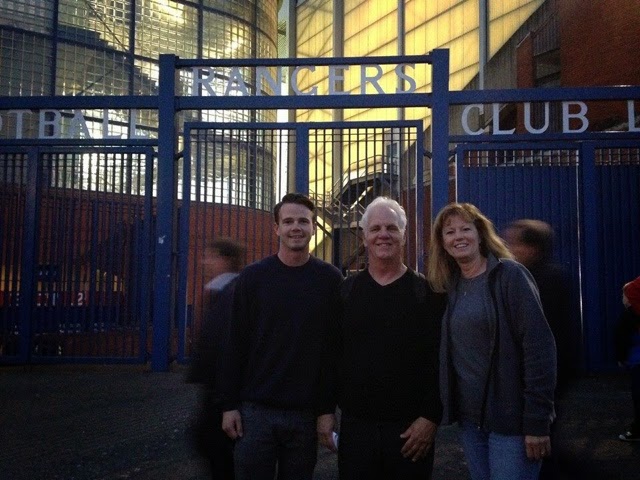After our puddle jumper from Paris, we touched down in Edinburgh, the capital of Scotland. Arriving just before sunset we headed over to our rental car, feeling a bit nervous about driving on the "wrong side of the road" as Scots drive on the left. How hard could it be!? Well, turns out pretty hard... It was incredibly scary making turns, driving through roundabouts in traffic, and navigating what would otherwise be routine driving- also our directions from Edinburgh to our small timeshare out in the country were terrible, turning what should have been a 1.5 hour drive into 3...
Dad freaking out inspecting our car... The steering wheel is on the wrong side! Luckily we calmed down for a few minutes before panicking again pulling out of the rental car lot...
We finally made it to our timeshare in Kilconquhar, a small hamlet of about 300 people and checked into our huge 3 bedroom house on the estate property. The main lodge was an old castle built in the 12th century and is the possible birthplace of Robert the Bruce, King of Scots in the early 14th century and one of Scotland's most famous warriors.
The morning after our harrowing drive to Kilconquhar, this was taken out our living room window. Being in such a small town in the countryside, driving would be our main form of transportation for the next several days, though it never got much more comfortable. Getting around really became a team sport, with dad at the wheel, me giving turn by turn directions and basically teaching a driving lesson from the passenger seat and mom closing her eyes and praying in the back seat...
Don't see phone booths around too much any more...
About ten minutes down narrow country roads from Kilconquhar is the Firth of Forth, the huge estuary where the River Forth flows into the ocean. Along the Firth, are a few quaint port towns that seem to stand timeless against the harsh, gray weather. A one lane highway connects these towns along the coast until you reach the North Sea, the road turns northward and you arrive in St Andrews. We followed the highway, leisurely stopping in the small towns to enjoy their quiet charm and snack on some must-have fish and chips.
Looking at Elie from its harbor at low tide. And below, boat repair is pretty easy when you have 15 foot tide swings...
Above and below, the old stone buildings of Elie. They could have been built 15 years ago or 500- it's hard to tell. To me, their ageless stone masonry was some of the coolest architecture I'd seen.
We stopped in Pittenweem for lunch and then at Crail to check out their old castle. Below, mom and dad stand at the shore on the Firth of Forth at Crail with the castle on the hill above.
Above, small town port life on the Firth of Forth.
Arriving to St Andrews in one piece was a nice relief and we walked around the city, checking out the old church, castle and obviously, the golf course.
Above and below, the Cathedral at Saint Andrews built in 1158. It fell into ruin in the 16th century when Catholic mass was outlawed in Scotland and looks much the same today as it did then after it fell into disrepair.
We also explored the St Andrews Castle, a ruin on a bluff stretching out into the bay. During the 12th and 13th century, the castle was a major stronghold that the Scots and English seemed to trade back and forth depending on the won its control. In the 16the century during the Scottish Reformation, it was a center of religious struggle. During one battle, the outsiders dug a mine to try to get inside and sack the castle but the defenders dug a counter-mine and stopped them in their tracks. We got to go below ground and check the tunnels out. Not for the claustrophobic!
Similar to the point I made earlier juxtaposing France with Peru during the 16th century, it was also interesting to compare mainland Europe with Scotland. While France, Italy and Spain went through the amazing times of discovery, art and architecture during Enlightenment, Scotland was still building simple stone forts and fighting gruesome wars over subtle differences in the interpretation of Christianity.
But it's not all death and darkness in Scotland. We visited the famous St Andrews Old Course, perhaps the best known golf course on earth. Above is the new clubhouse and hotel and below is the renowned old clubhouse on the left side of the photo and view up the 18th fairway. The Scots we met were always baffled that we weren't in their country to play golf - seems like that was the only reason they fathomed Americans would be there. Glad we didn't play though, as the 10 foot deep sand traps on the Old Course would've been quite humbling...
While known as having terrible food, to me Scotland was heaven as I found they had excellent pub food consisting of fried fish, mashed potatoes, meatloaf and fries (or chips as they call them) all over the place with such unique dish names such as "mince and tatties." On one of our visits to St Andrews we ate some food to go on the famous of their university. With the old buildings and stone architecture it felt more like Hogwarts in Harry Potter than a world renowned institution.


























































